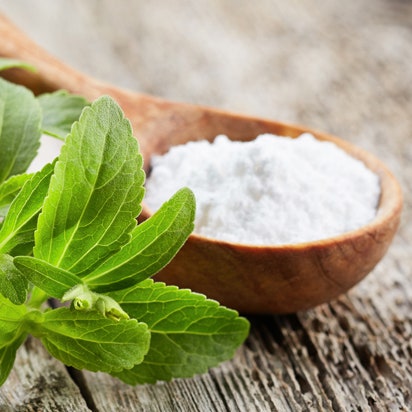
Stevia taste science
Understand the science behind great-tasting products with stevia.

Sensory science
Taste is one of the most important aspects of stevia, and achieving great taste with stevia requires a scientific approach. In this article, we explore the technical methods and case studies showcasing the synergies and taste breakthroughs of the 70+ steviol glycosides.
One of the ways the taste of stevia is evaluated is by using a scientific method called sensory evaluation.
Introduction to taste science
Steviol glycosides are compounds found naturally occurring in the stevia leaf and are responsible for the taste attributes of stevia. Sweetness is the key taste impact of most steviol glycosides. However, they can also bring bitter perception as well as contribute to how people perceive sour, salty, umami and certain tonal flavors like chocolate or vanilla, all depending on how the stevia is being used.
The taste of stevia is very complex and can be different depending on what application you put it into, such as beverages, dairy, baked goods, cereals and sweets.
What is sensory evaluation?
A scientific method known as sensory evaluation is used to assess the taste of many varieties of stevia for a multitude of applications. Sensory evaluation is used to evoke, measure, analyze and interpret those responses to products that are perceived by the five senses of sight, smell, touch, taste and hearing.4 People who conduct sensory evaluation research are referred to as sensory scientists. Sensory scientists evaluate products using panels of human taste evaluators and a series of standardized methods. Statistical techniques are applied to results to draw inferences and make conclusions. Most large consumer goods companies have departments dedicated to sensory evaluation.
Taste and flavor
With stevia, much of the sensory evaluation research focuses on the sense of taste. Taste is the sensation produced when a substance in the mouth reacts chemically with taste receptor cells located on the taste buds. The five basic tastes perceived by the tongue are sweet, sour, salty, bitter and umami. Of these, sweet and bitter are the tastes prevalent in stevia, and most stevia related sensory research focuses on maximizing sweet taste and minimizing bitterness. However, as more compounds are isolated and investigated, their impact on other basic tastes continues to be studied. Beyond sweet and bitter, emerging research indicates stevia may change the perception of other tastes such as salty.7
Human taste perception, especially for bitter tastes, can vary greatly among individuals due to genetic variation.2 Understanding this variability is a challenge for sensory scientists working with stevia.
The five basic tastes are part of a larger sensory experience known as flavor. What most people think of as taste is really flavor. Flavor is the combined sensation from three modes of sensory perception: aromas identified within the nose, basic tastes perceived on the tongue and mouthfeels that stimulate nerves in the oral cavity. Aromas can be perceived in two ways. The first is retronasal olfaction, which is when aromas drift up the back of the throat during eating and drinking. The second is orthonasal olfaction, which occurs during sniffing.6
Some stevia extracts, especially those made from whole leaf stevia, have undesirable licorice aromas. Stevia’s licorice-like aromatics stem from more than 40 different aromatic chemicals identified in the stevia plant.5 Some of the top aromatic chemicals in stevia leaves include spathulenol, caryophyllene oxide, β-caryophyllene and β-pinene.
Sensory evaluation tools used to evaluate stevia
Sensory evaluation methods mainly rely on human assessors and commonly fall into three main categories: discrimination testing, descriptive evaluation and consumer testing (see table below).
Sensory evaluation is comprised of 3 primary methodologies
- Triangle testing
- Duo trio testing
- Threshold testing
- Quality control
- Cost reduction
- Ingredient substitution
- Quantitative Descriptive Analysis
- Spectrum method
- Time intensity
- Optimization
- Market place analysis
- Quality control
- Focus groups
- Internet surveys
- New product launch
- Idea generation
Sensory scientists rely on many of these techniques to evaluate stevia. Discrimination testing is often utilized to determine if a product made with stevia is similar in taste to its full sugar counterpart. For example, a triangle test might evaluate a full sugar version of ice cream versus one with a 25% reduction in sugar using stevia. Taste panelists would be served three samples, two of the same and one that is different. If panelists consistently fail to pick out the odd sample, the conclusion would be that the reduced-sugar version is similar to the full-sugar version.
Descriptive evaluation is used to describe the sensory attributes of foods and beverages made with stevia. This type of sensory test is usually performed with highly trained taste panelists who use a standardized vocabulary called a lexicon to describe the sensory attributes of samples. The lexicon for stevia includes terms such as sweet, bitter, licorice, astringent and metallic. If stevia is placed into a food such as ice cream, then the taste panel would also rely on the lexicon for that product to determine how stevia changes the sensory profile. For example, in soft ice cream utilizing stevia to replace sugar, reduced sugar versions had less total flavor, were thinner in texture and melted faster.1 Reducing sugar in foods and beverages is technically challenging, and findings such as these provide clear direction on progress and next steps.
A trained descriptive evaluation panel can also measure the temporal, or time related, changes in flavor and texture over time.3 This technique is often referred to as time intensity. For instance, with ice cream containing stevia, a time intensity panel might measure how quickly the sweet taste develops, how long it lasts in the mouth and the duration of the sweet aftertaste.
Consumer research utilizes untrained taste panelists who typically are product category users. In the case of stevia, the most important question is if users of a food or beverage will find the reduced-sugar versions acceptable. This can be accomplished by asking consumers how much they like or dislike products using a scale or by asking them which product they prefer. It is also common to ask consumers their opinion on the amount of certain sensory attributes using a scale called "just-about-right.” For example, you might ask a consumer if the sweet taste in a sample of vanilla ice cream is too little, just right or too much. These methods are all referred to as quantitative consumer testing, and numerical scores are analyzed using statistics.
Consumer research can also be qualitative, which seeks to understand the abstract and subjective attributes of a product. This can be done by simply asking someone what they liked or disliked about a sample, which is referred to as an open-ended response. Another popular technique is to conduct a focus group, which is a moderated group discussion that seeks to understand consumers’ perceptions, opinions, attitudes and beliefs. For instance, food manufactures might utilize information from a focus group on sugar claims in food and drink products to better communicate sugar reduction.5
Conclusion
Understanding the mechanisms of taste and smell, as well as the methods that sensory scientists employ, allows for an informed decision when using stevia. This will empower more food and beverage companies to leverage stevia for the creation of great-tasting products with less sugar and fewer total calories.
Other stevia science and research
References
- Alizadeh, M. & Azizi-Lalabadi, M. Impact of using stevia on physicochemical, sensory, rheology and glycemic index of soft ice cream. Food Nutr. (Roma). (2014).
- Bachmanov, A. A. et al. Genetics of taste receptors. Curr. Pharm. Des. 20, 2669–83 (2014).
- Cliff, M. & Heymann, H. Development and use of time-intensity methodology for sensory evaluation: A review. Food Res. Int. (1993).
- Lawless, H. & Heymann, H. Sensory evaluation of food: principles and practices. (Springer Science & Business Media, 2010).
- Patterson, N. J., Sadler, M. J. & Cooper, J. M. Consumer understanding of sugars claims on food and drink products. Nutr. Bull. 37, 121–130 (2012).
- Rozin, P. "Taste-smell confusions" and the duality of the olfactory sense. Percept. Psychophys. 31, 397–401 (1982).
- Toldrá, F. & Barat, J. Strategies for salt reduction in foods. Recent patents food, Nutr. (2012).








